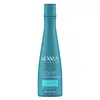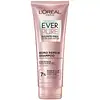What's inside
What's inside
 Key Ingredients
Key Ingredients

 Benefits
Benefits

 Concerns
Concerns

 Ingredients Side-by-side
Ingredients Side-by-side

Water
Skin ConditioningCetearyl Alcohol
EmollientDimethicone
EmollientStearamidopropyl Dimethylamine
EmulsifyingBehentrimonium Chloride
PreservativeParfum
MaskingAcrylamidopropyltrimonium Chloride/Acrylamide Copolymer
Lactic Acid
BufferingDipropylene Glycol
HumectantAmodimethicone
Gluconolactone
Skin ConditioningSodium Chloride
MaskingTrehalose
HumectantDisodium EDTA
Cetrimonium Chloride
AntimicrobialPEG-7 Propylheptyl Ether
Emulsion StabilisingTocopheryl Acetate
AntioxidantMethylchloroisothiazolinone
PreservativeC10-40 Isoalkylamidopropylethyldimonium Ethosulfate
Hydrolyzed Sweet Almond Protein
Skin ConditioningMethylisothiazolinone
PreservativeHydrolyzed Keratin
HumectantHydrolyzed Wheat Protein
Skin ConditioningJasminum Officinale Flower Extract
MaskingBenzyl Alcohol
PerfumingBenzyl Salicylate
PerfumingLimonene
PerfumingLinalool
PerfumingWater, Cetearyl Alcohol, Dimethicone, Stearamidopropyl Dimethylamine, Behentrimonium Chloride, Parfum, Acrylamidopropyltrimonium Chloride/Acrylamide Copolymer, Lactic Acid, Dipropylene Glycol, Amodimethicone, Gluconolactone, Sodium Chloride, Trehalose, Disodium EDTA, Cetrimonium Chloride, PEG-7 Propylheptyl Ether, Tocopheryl Acetate, Methylchloroisothiazolinone, C10-40 Isoalkylamidopropylethyldimonium Ethosulfate, Hydrolyzed Sweet Almond Protein, Methylisothiazolinone, Hydrolyzed Keratin, Hydrolyzed Wheat Protein, Jasminum Officinale Flower Extract, Benzyl Alcohol, Benzyl Salicylate, Limonene, Linalool
Water
Skin ConditioningSodium C14-16 Olefin Sulfonate
CleansingCocamide Mea
EmulsifyingGlycerin
HumectantCocamidopropyl Betaine
CleansingGlycol Distearate
EmollientSodium Lauroyl Sarcosinate
CleansingHexylene Glycol
EmulsifyingCitric Acid
BufferingParfum
MaskingSodium Hydroxide
BufferingSodium Chloride
MaskingSodium Benzoate
MaskingPEG-55 Propylene Glycol Oleate
Propylene Glycol
HumectantCoco-Betaine
CleansingHydroxypropyl Guar Hydroxypropyltrimonium Chloride
Carbomer
Emulsion StabilisingSalicylic Acid
MaskingBenzoic Acid
MaskingPolyquaternium-7
Linalool
PerfumingLimonene
PerfumingHydroxycitronellal
PerfumingCitronellol
PerfumingWater, Sodium C14-16 Olefin Sulfonate, Cocamide Mea, Glycerin, Cocamidopropyl Betaine, Glycol Distearate, Sodium Lauroyl Sarcosinate, Hexylene Glycol, Citric Acid, Parfum, Sodium Hydroxide, Sodium Chloride, Sodium Benzoate, PEG-55 Propylene Glycol Oleate, Propylene Glycol, Coco-Betaine, Hydroxypropyl Guar Hydroxypropyltrimonium Chloride, Carbomer, Salicylic Acid, Benzoic Acid, Polyquaternium-7, Linalool, Limonene, Hydroxycitronellal, Citronellol
Ingredients Explained
These ingredients are found in both products.
Ingredients higher up in an ingredient list are typically present in a larger amount.
Limonene is a fragrance that adds scent and taste to a formulation.
It's found in the peel oil of citrus fruits and other plants such as lavender and eucalyptus. The scent of limonene is generally described as "sweet citrus".
Limonene acts as an antioxidant, meaning it helps neutralize free radicals.
When exposed to air, oxidized limonene may sensitize the skin. Because of this, limonene is often avoided by people with sensitive skin.
The term 'fragrance' is not regulated in many countries. In many cases, it is up to the brand to define this term. For instance, many brands choose to label themselves as "fragrance-free" because they are not using synthetic fragrances. However, their products may still contain ingredients such as essential oils that are considered a fragrance.
Learn more about LimoneneLinalool is a fragrance and helps add scent to products. It's derived from common plants such as cinnamon, mint, citrus, and lavender.
Like Limonene, this ingredient oxidizes when exposed to air. Oxidized linalool can cause allergies and skin sensitivity.
This ingredient has a scent that is floral, spicy tropical, and citrus-like.
Learn more about LinaloolParfum is a catch-all term for an ingredient or more that is used to give a scent to products.
Also called "fragrance", this ingredient can be a blend of hundreds of chemicals or plant oils. This means every product with "fragrance" or "parfum" in the ingredients list is a different mixture.
For instance, Habanolide is a proprietary trade name for a specific aroma chemical. When used as a fragrance ingredient in cosmetics, most aroma chemicals fall under the broad labeling category of “FRAGRANCE” or “PARFUM” according to EU and US regulations.
The term 'parfum' or 'fragrance' is not regulated in many countries. In many cases, it is up to the brand to define this term.
For instance, many brands choose to label themselves as "fragrance-free" because they are not using synthetic fragrances. However, their products may still contain ingredients such as essential oils that are considered a fragrance by INCI standards.
One example is Calendula flower extract. Calendula is an essential oil that still imparts a scent or 'fragrance'.
Depending on the blend, the ingredients in the mixture can cause allergies and sensitivities on the skin. Some ingredients that are known EU allergens include linalool and citronellol.
Parfum can also be used to mask or cover an unpleasant scent.
The bottom line is: not all fragrances/parfum/ingredients are created equally. If you are worried about fragrances, we recommend taking a closer look at an ingredient. And of course, we always recommend speaking with a professional.
Learn more about ParfumChances are, you eat sodium chloride every day. Sodium Chloride is also known as table salt.
This ingredient has many purposes in skincare: thickener, emulsifier, and exfoliator.
You'll most likely find this ingredient in cleansers where it is used to create a gel-like texture. As an emulsifier, it also prevents ingredients from separating.
There is much debate on whether this ingredient is comedogenic. The short answer - comedogenic ratings don't tell the whole story. Learn more about comegodenic ratings here.
The concensus about this ingredient causing acne seems to be divided. Research is needed to understand if this ingredient does cause acne.
Scrubs may use salt as the primary exfoliating ingredient.
Learn more about Sodium ChlorideWater. It's the most common cosmetic ingredient of all. You'll usually see it at the top of ingredient lists, meaning that it makes up the largest part of the product.
So why is it so popular? Water most often acts as a solvent - this means that it helps dissolve other ingredients into the formulation.
You'll also recognize water as that liquid we all need to stay alive. If you see this, drink a glass of water. Stay hydrated!
Learn more about Water